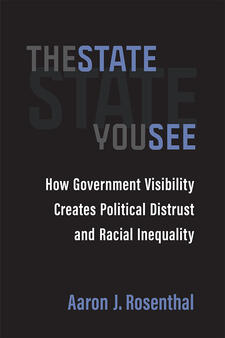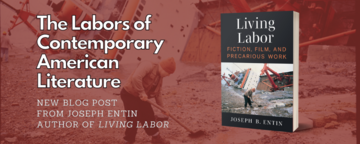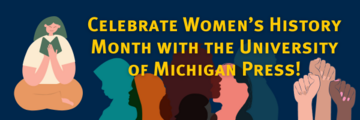Q&A with Aaron Rosenthal

This guest author post is a Q&A with Aaron J. Rosenthal, author of The State You See: How Government Visibility Creates Political Distrust and Racial Inequality , from the University of Michigan Press. This book is available in hardcover, paper, and open access.
What surprised you the most while researching?
There were several surprises in the research process, but two stick out to me the most.
First, I had an early interest in the way that government appears in people’s lives and dove into the research that had been done on state visibility. There is a ton of really impressive work that has been done in this area, but almost all of it has focused on ways government has become less visible in people’s lives, primarily through the growth in tax breaks that provide financial assistance to people in hidden ways. There’s no doubt that this is a crucial shift in American governance, with the cost of tax breaks now being roughly equal to Social Security and Medicare combined, but what surprised me was how little attention had been given to the parts of government that remained visible, or had become more visible, in people’s lives. With so little to go on in the existing scholarship, investigating that question required sitting down with individuals to ask them how they saw the government showing up.
Having those conversations led to my second surprise, which was how willing people were to open up to me about their understanding of, and experiences with, government. I took steps to ensure people would feel more comfortable talking with me, but even with those actions, I was asking a lot of the individuals I interviewed. The generosity that so many communities and people showed me, often letting me into their homes and talking with me for multiple hours, truly amazed me. The scariest part of this book coming out is hoping that it lives up to the labor and trust that everyone gave to me.
In your book you find that there is a racial gap in why different Americans distrust the government. Can you summarize some of the differences and similarities in how different Americans view the government?
View is an important word in that question, but in a literal sense. Much of my argument is that differences in why people distrust the government stem from differences in the way people view government in their lives (or more precisely, the ways government is made visible to them, as discussed in the previous answer).
In particular, I argue that several policy trends have come together over the last fifty years to shift the way government appears in people’s lives, with a strong racial split being created within that appearance. For white people, these policy changes have involved the rising number of generous benefits submerged within America’s tax code that flow to wealthy, white Americans, combined with an increased stereotype of welfare dollars primarily going to Black Americans and greater political attention being given to taxes. In combination, these trends have left white people with the misperception that the government does nothing for them, apart from taking their tax money to spend on welfare. Distrust of government is the result. For people of color, distrust is also rampant but for different reasons. Over the last few decades, America has witnessed increasingly overbearing policing and swelling incarceration numbers. These changes have disproportionately impacted communities of color, helping to make the criminal legal system a uniquely visible manifestation of government in these communities.
The result is that people from different racial groups may see a different state, but everyone distrusts the state they see.
Why is trust, or distrust, in government important?
It’s important to start with the fact that trust in government has declined tremendously over the last six decades. Roughly three in four Americans said they trusted the government most or all of the time in 1964. Now it’s one in five.
That decline has some crucial implications on its own. A lack of confidence in government can lead to a vicious cycle in which people refuse to participate in public services, leading to a subsequent decline in the quality of those services. More recently, research has suggested that distrust in government was a key predictor of COVID-19 infection and mortality rates because of its association with people’s willingness to follow government orders and accept government vaccines.
Beyond these impacts, my research suggests that distrust has an important effect on American democracy. Past research has found that distrust of government is not linked to people’s likelihood of participating in the political process, but I find that this lack of connection masks an important racial contingency. Distrust mobilizes white people to engage in electoral politics (e.g., vote, volunteer for a campaign) because it is linked to a sense of misspent tax dollars. In contrast, distrust pushes people of color away from electoral participation because of its connection to a fear of the criminal legal system. Racial inequality in America’s elections is the result.
Do you have recommendations for how policy reforms should respond to distrust?
Any policy reform aimed at building trust must take into account how it will shift the most visible manifestations of government in people’s lives. In the book, I refer to these most visible manifestations as people’s location of the state, meaning the parts of government that people use to understand what the government is and does, and thus are most likely to draw on when they form their broader trust evaluations. I argue that since the criminal legal system has become the most widely visible manifestation of government among people of color in America today, it makes sense that declining trust in the criminal legal system is tied to declining trust in government within communities of color.
From this perspective, there are two important pathways for building trust. First, policy can seek to change the parts of government that are most visible for people, such that their locations of the state become more trustworthy entities (e.g., making something other than the criminal legal system a more visible representative of government in communities of color). Second, policies can work to restructure the way already visible manifestations of government relate to individuals, such that people are more likely to develop trust based on their interactions with those parts of government (e.g., changing the way the criminal legal system relates to people of color).
I believe a universal basic income (UBI) program is uniquely suited to building trust along the first pathway of changing the most visible parts of government. To start, as compared to benefits provided as tax breaks that people tend to not associate with the government, a UBI is delivered as a treasury check, making its public origins obvious (much in the way Social Security functions today). In addition, its universality means that everyone will see this check, breaking the common trend in American social policy of creating divisions which tend to reinforce misperceptions (often racist ones) that some individuals receive more aid from the government than others. Finally, a UBI is generous by definition, meaning that people will feel the impact of the benefit. This combination of universality, generosity, and obvious connection to government has the potential to do more to shift state visibility than any other policy reform.
As for the second pathway of restructuring existing visible entities, there are numerous promising avenues. Staying with the example of the criminal legal system, strategies that combine focusing law enforcement on serious crime, as opposed to widespread arrests for low level crimes, with assistance from social service agencies, have been shown to increase confidence in the police, and therefore may also be successful in boosting trust in government more broadly.
What do you hope readers will take away from reading The State You See?
Racial inequality has been constant in the US. One force driving that persistent dynamic is people from different racial groups being exposed to different forms of governance. This country was founded in governing Black people and Native Americans through exploitation and extraction in order to fund a liberal society for white, property holding men.
While racial differences in experiences of government may not be as drastic today, important similarities remain. Fines and fees disproportionately imposed on people of color by the criminal legal system help to make up for local government budget shortfalls, such that more than 700 municipalities today utilize these fees for at least 10 percent of city revenue. These shortfalls are caused in part by reduced federal aid, which in turn stems from increased federal revenue lost to generous tax breaks for the white and wealthy. To counteract this form of state-sanctioned racial inequality, it is important to understand how it is similar to past forms, and also how it differs.
In these efforts, I think it is important to remember that the issue is not individual failure. It’s easy to look at the lack of trust in government today and advocate for individuals educating themselves to more accurately understand what the government does. That is not the message of the book. Instead, I’m arguing that public policy choices have been made that actively lead individuals to distrust government, and subsequently foster racially patterned political inequality. If public policy is the problem, then public policy must also be the solution.





